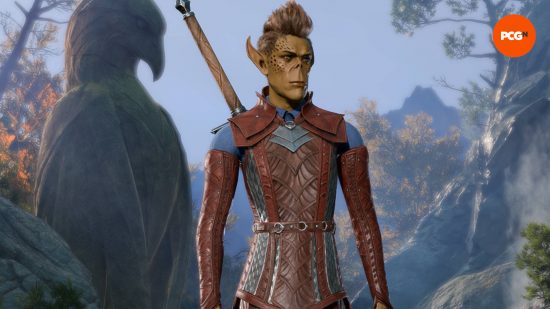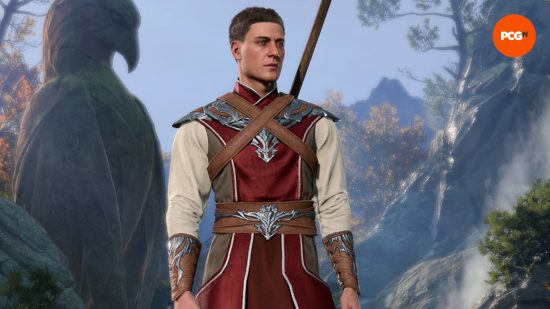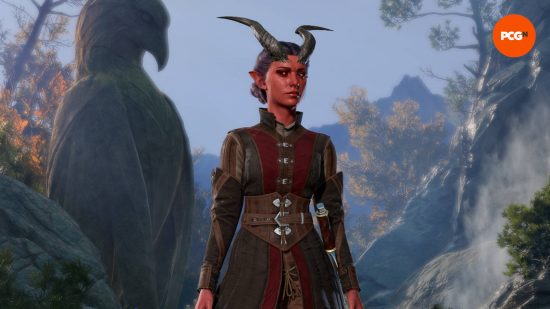Which Baldur’s Gate 3 race should you pick? No matter which one you choose, the opening cinematic shows them becoming an unwilling host to a toothy little eyeball tadpole. It threatens to transform us into a Mind Flayer – an evil Eldritch creature with powerful magical abilities. Of course, you won’t have any control over the presence of your parasite pal wriggling around your insides, but you can at least customize your character’s appearance.
Baldur’s Gate 3 has a wide variety of races to choose from, with some divided into unique subraces that come with their own perks. If you create your character, you can additionally select your class and character background, perhaps even taking on the Dark Urge origin. It’s time to take a closer look at the character archetypes to explore the Forgotten Realms. Now, let’s explore all the BG3 races and which one to pick.

Baldur’s Gate 3 race list
There are 11 playable Baldur’s Gate 3 races, each a staple of the Dungeons and Dragons fifth edition. Most have at least some subraces with unique feats and traits. You can learn more about each race, including their proficiencies, by following the links in their description.
Here are all of the Baldur’s Gate races:
- Dragonborn
- Drow
- Dwarf
- Elf
- Gnome
- Githyanki
- Half-Elf
- Half-Orc
- Halfling
- Human
- Tiefling
Dragonborn
The Dragonborn race is descended from dragons, and for a long time, they were enslaved by them. They share some traits, such as breathing destructive elemental energy and resisting certain attacks. Since gaining their freedom, they strive to live independently without being indebted to anyone.
There are many subraces for the Dragonborn, one for each of the ten types of dragons you can find in Dungeons and Dragons. Some breathe fire like most depictions of dragons in fantasy novels, but they can also breathe lightning, acid, poison, and freezing air.
Drow
As one of the most hated races in Faerûn, the Drow tend to shy away from the rest of society, instead opting to live in the dark underground caverns. Those who do choose to live on the surface are met with intolerance and spite. Due to an internal ancient feud between two Elven deities, the Seldarine Drow are the ones who tend to live on the surface, seeking help from allies against the Lolth-Sworn Drow, who worship the spider queen and are considered merciless and cruel.
Followers of Lolth have red eyes, but there are no other real differences between the two. They share the same fey ancestry to resist charm magic and have superior Darkvision that’s essential for cave-dwelling. Since they are an elf variant, they move faster than most races and can use magic well, but their shadowy nature also makes them great candidates for rogues or rangers.
Dwarf
If you choose the Dwarf, you’ll play as one of the oldest races in the Forgotten Realms. They’re a proud, if somewhat stubborn, race that calls the towering mountains their home. They are a hardy race with the ability to wield axes and hammers with expert proficiency, and they can see in the dark.
There are three subraces – Gold Dwarves, Shield Dwarves, and Duergar. Gold Dwarves have a keen eye for quality materials, valuing the finely crafted gear they smith in the mountains. They also are close to their families and strict with their rituals. Shield Dwarves are the more battle-hardy of the two subraces as they have constantly been at war with goblins and orcs.
The Duergar have spent so long in the Underdark that they have been transformed into stony-faced creatures, altered over generations of their kind, and were experimented on by Mind Flayers and Aberrations. As such, they have access to psionic powers and can avoid being charmed or stunned.
Elf
A Baldur’s Gate 3 Elf is not too unlike other interpretations of this famous fantasy creature, such as Lord of the Rings. In Dungeons and Dragons, the Elves are split into two subraces. High Elves are graceful, intelligent, and magically intuned. As a result, they learn a cantrip from the Wizard spell list for free. They also have a detached view of the world outside their bubble. They are typically unconcerned with trifling issues that only span a few years but will aid if their friends are threatened.
On the other hand, the Wood Elves are more in tune with nature. As a result, they will fiercely and swiftly defend their homeland with stealth tactics and their Fleet of Foot feat. High Elves would do better with magic-based classes, while Wood Elves are more typically Rangers or Rogues.
Githyanki
The Githyanki are a Dungeons and Dragons-specific race that the Mind Flayers originally enslaved. They were ruthless pillagers and raiders of many worlds within the Prime Material plane, with a militaristic society with little respect for the rules.
Since their exodus from the Mind Flayers, the Githyanki now seek to stop their former masters, though they are viewed by other races initially with contempt. However, they can overcome prejudice and earn mutual respect with enough patience on both sides.
Gnome
A race as widely diverse as the Baldur’s Gate 3 Gnome is capable of many incredible feats. They’re naturally smart, somewhat making up for their base height, but each subrace has unique traits.
Deep Gnomes live underground, with great camouflage, speed, and superior Darkvision. Forest Gnomes focus on nature, as they can gain the ability to comprehend and verbally speak with animals. The Rock Gnomes love to tinker around with metal and rock and are more bookish than the other Gnome subraces, as they have a proficiency bonus to history checks. Depending on their subrace, Your best with a Gnome is either Rogue, Ranger, or Wizard.
Half-Elf
Often existing on the edges of both human and elven societies, the Half-Elf inherits some key characteristics from both cultures. They have the gracefulness and long-giving characteristics of an Elf but the drive and ambition of the Human side.
Half-Elves come in the same subraces as the regular Elves and are keen to learn anything from their Elven heritage. They’re not as good as them at any of these traits, but they will still gain resist charm effects that a High Elf would wield, the stealth proficiency of a Wood Elf, or even the Drow’s ability to summon light from nowhere. They excel as sorcerers, warlocks, and bards.
Half-Orc
As one of the few strength-based races, the Half-Orc has a mixture of human and orc traits. As such, they are creatures of intense emotion who would rather hit first and ask questions later. They’re constantly at odds with themselves, and their inner rage compels them to fight.
However, their human side allows them to care for another being, with some becoming so inspired that they perform incredibly heroic feats. They can return from dire circumstances in combat with their Relentless Endurance feat. We recommend Barbarian, Fighter, and other melee-based classes, as the Savage Attacks feat triggers with critical hits from melee weapons and give the Half-Orc an additional dice of damage.
Halfling
Smaller than the average human but full of heart, a Halfling is joyful by nature and tends to avoid the attention of the larger creatures that live around them. However, they’re practical and concerned with their immediate surroundings, doing whatever they can to help if called to action.
There are two Halfling subraces, with Lightfoot Halflings making for natural thieves with their increased charisma and proficiency in stealth checks. Strongheart Halflings, on the other hand, are more resilient against poison damage and have a higher base constitution.
Human
The Baldur’s Gate 3 Human race is, by far, the most common people found in the Forgotten Realms and adaptable to any surroundings. While they don’t begin with additional abilities or feats, they get a bonus point in every stat. With no real disadvantages, you can use any class and do well.
Tiefling
Tieflings may have had evil ancestors who were descended from demons and fiends, but they were not predisposed to evil alignments. Known for their cunning and personal allure, they make for inspiring leaders. A bond with a Tiefling is rarely broken when made, so if other races demonstrate friendship and trust, it would be returned in full.
There are three subraces; each one bound to a particular demon of hell. Asmodeus Tieflings wield fire and darkness magic, while Mephistopheles Tieflings have arcane power coursing through their veins. Zariel Tieflings are more strength-focused, imbuing themselves with fire magic to power up their attacks.
Which Baldur’s Gate 3 race should you choose?
While your chosen Baldur’s Gate 3 race ultimately depends on your personal preference, the Elf is among the best options thanks to its versatility, with any Elf subrace offering significant benefits.
As with any character creation, the race you select will of course depend on your preferences and playstyles: those with a devilish side might want to play as a horned tiefling, while fans of nature could play as a graceful elf.
Speaking of elves, their base features make them an excellent choice, with natural Darkvision and a proficiency bonus in perception being particularly useful all-around skills. Wood elves excel in stealth, while High Elves are more attuned to magic, gaining a wizard cantrip. However, if you prefer strength over sleight, you might want to choose a race like the Githyanki, who have an automatic +2 buff to the strength stat.
 Baldur’s Gate: The Complete Saga Baldur’s Gate: The Complete Saga $82.73 Play now
Baldur’s Gate: The Complete Saga Baldur’s Gate: The Complete Saga $82.73 Play now
Those are all the Baldur’s Gate 3 races. On your adventure through the Forgotten Realms, a handful of Baldur’s Gate 3 companions, such as the High-Elf Rogue Astarion and High Half-Elf Cleric Shadowheart, can join you. You can also learn more about how to interact with your companions by visiting the Baldur’s Gate 3 camp, where you can change party members to suit your needs.











